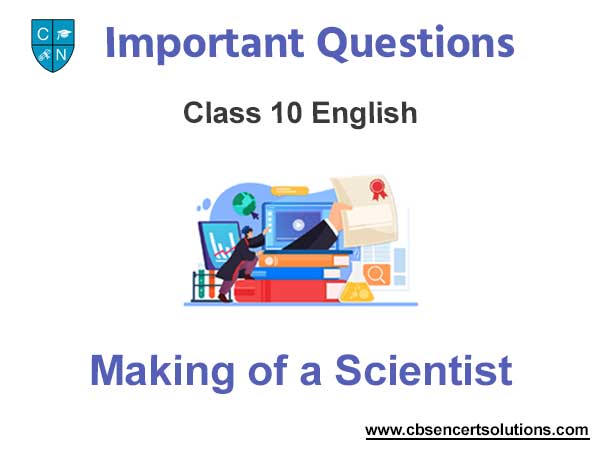Please refer to Making of a Scientist Class 10 English Important Questions given below. These solved questions for Making of a Scientist have been prepared based on the latest CBSE, NCERT and KVS syllabus and books issued for the current academic year. We have provided important examination questions for Class 10 English all chapters.
Class 10 English Making of a Scientist Important Questions
Short Answer Type Questions
Question. Why did Richard begin to lose interest in tagging butterflies?
Ans. Tagging butterflies was a tedious process with not much feedback. In all the time that he tagged butterflies, only two were reported caught and that too from near his home.
Question. Which project of Ebright enabled him to work at the army lab and at the U.S. Department of Agriculture’s laboratory?
Ans. In his senior year, Ebright grew cells from a monarch’s wing in a culture. He showed that the cells would divide. They would develop into normal butterfly wing scales only in one way. It was if they were fed the hormone from the gold spots. This was a huge theory, this enabled him to work at the army lab and at the U.S. Department of Agricultural
Laboratory.
Question. Apart from science research what else was Richard interested in?
Ans. Apart from being a scientist, Richard was also a champion debater, public speaker, a good canoeist and an all-round outdoor-person. He was also an expert photographer, particularly of nature and scientific exhibits.
Question. Which book did Ebright’s mother get for him? How did it change his life.
Ans. Ebright’s mother got him a children’s book titled ‘The Travels of Monarch X’. The book described how Monarch butterflies migrate to Central America. This opened the world of science to the young and enthused collector, Ebright.
Question. Why did Ebright raise a bunch of butterflies?
Ans. Ebright wanted to catch butterflies to tag them in order to follow their migration. He realised that it was easier to raise them in his basement rather than try and catch them one by one. So he would catch a female Monarch, take her eggs and help them grow into butterflies which he would tag.
Long Answer Type Questions
Question. Who inspired Ebright further after he had collected all twenty-five species of butterflies found around his hometown? What did Ebright do?
Ans. Ebright had collected all the twenty-five species of butterflies in second grade. His mother got him a children’s book called ‘The Travels of Monarch X’.
Which opened the world of science to Ebright. The readers were invited to help study butterfly migrations. They were asked to tag butterflies for research by Dr. Frederick A. Urquhart of Totonto University, Canada. Ebright started tagging the butterflies. He would tag the butterflies wings and let them go. But he couldn’t catch many. He caught a female monarch and took her eggs. He raised them in his basement from eggs to adult butterflies.
Question. Which research did Ebright begin in his second year in high school? Which new theory did it lead to?
Ans. In his second year, Ebright began the research.
Which led to his discovery of an unknown insect hormone. Indirectly, it also led to his new theory on the life of cells. Ebright tried to answer the question that asked the purpose of the twelve tiny gold spots on a monarch pupa? Everyone thought the spots were just ornamental. But Dr. Urquhart didn’t believe it. Ebright and another science student built a device which showed that the spots were producing a hormone. It was necessary for the butterfly’s development. This project won Ebright first place in the country fair. It also won him an entry into the International Science and Engineering Fair.
Question. How did Ebright get the idea for his new theory about cell life? How important was it and how will it be useful for humanity?
Ans. Ebright got the idea for his new theory about cell life during his junior year. While he was looking at X-ray photos, the idea struck him. The photos were that of the chemical structure of a hormone. He believed that the photos gave him the answer to the biological puzzle that asked how can the cell read the blueprint of its DNA. He deduced that DNA is the blueprint of life. Ebright and his roommate James R. Wong drew pictures and made plastic models of molecules. They also wrote the research paper that explained the theory. If the theory proves correct, it will be a big step towards understanding the processes of life. It might also lead to new ideas for preventing cancer and other diseases.

